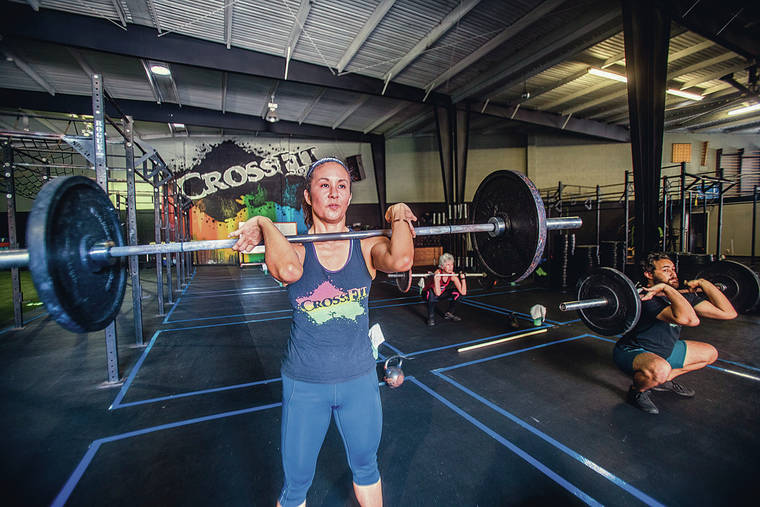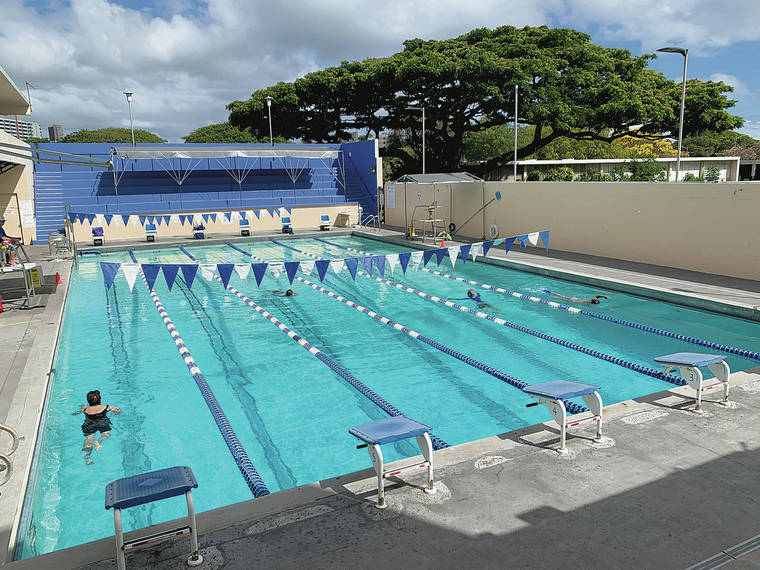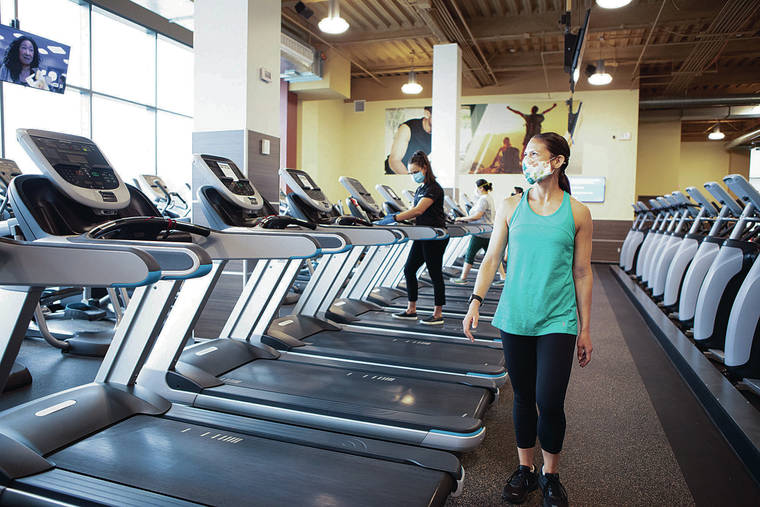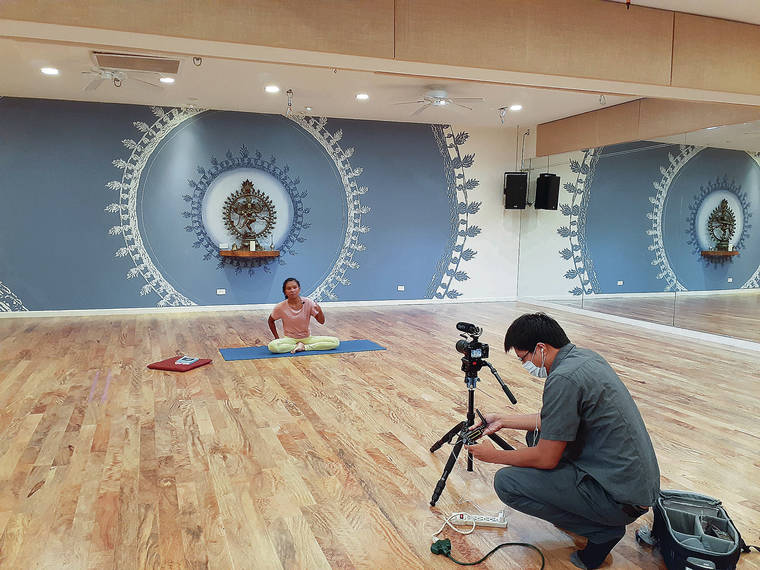Hawaii gyms and fitness centers reopen for those ready to work out

DENNIS ODA / DODA@STARADVERTISER.COM
CrossFit Oahu has taped its floor to designate where guests should exercise to maintain social distancing. Sandra Robbins, front, Maureen Sapienza and Bryant Powers, owner of CrossFit Oahu, demonstrate how to squat while using social distancing measures.

COURTESY YMCA OF HONOLULU
The YMCA of Honolulu, which has about 25,000 members, reopens its fitness facilities today. On Monday it reopened its swimming pools.

COURTESY 24 HOUR FITNESS
Earlier this week 24 Hour Fitness filed for Chapter 11 bankruptcy, but six locations on Oahu are expected to reopen today.

COURTESY STILL & MOVING CENTER
Classes at Still & Moving Center in Kakaako are being livestreamed. The company will remain online, with in-person classes possibly in July.




Bryant Powers, owner of CrossFit Oahu in Kakaako, is upbeat about reopening today — the place has been deep-cleaned, the floor taped off into individual zones, and equipment is ready to go.
“We’ve done a lot,” he said. “We are changing the programming so that when people come, everything they use is going to be in that area.”
Gyms, yoga studios and fitness clubs on Oahu shuttered since mid-March are allowed to reopen today, along with movie theaters, museums and bars Opens in a new tab, under Mayor Kirk Caldwell’s latest phase of reopening the economy for business.
Classes will be a little shorter, according to Powers, who started CrossFit Oahu Opens in a new tab 15 years ago, and participants will each get an 8-by-8-foot bordered area in which to work out. There will be an in-and-out flow, and people will be asked to bring their own personal water bottles.
But his 13,000-square-foot gym is spacious, and he expects to still be able to accommodate 15 to 20 participants in what he calls the “back in shape” program. His part-time trainers — many of whom work other jobs as firefighters and physicians — are also eager to get back.
Powers said he closed down the gym March 18, a week before the state’s formal “stay-at-home” order went into effect.
Don't miss out on what's happening!
Stay in touch with breaking news, as it happens, conveniently in your email inbox. It's FREE!
“Ultimately, we’re a health business, so you want to make the healthiest decision for people,” he said.
But it has been a tough three months, with the gym completely shut down and no revenue coming in. Before the pandemic, Powers had never missed a month of rent. Even with federal loans secured, he expects it to be an uphill battle in months ahead.
What CrossFit Oahu did during its closure is loan out equipment to its approximately 500 members in Kakaako and Pearl City, and offer daily workouts via email.
There were also a few online Zoom events, which included a “plank-athon,” where participants competed to see who could hold a plank the longest, as well as a “deck of cards” workout, which challenged members to a specific exercise depending on the card drawn.
Powers said he contacted every member to offer them the option of continuing their membership, donating it or pausing it until reopening time. He estimates about a quarter of members stayed on and that the most loyal ones will return, but he expects others to drop off.
Also, he does not expect to get additional revenue from out-of-state, drop-in members due to travel restrictions. He used to get more than 100 drop-ins a month from travelers, who would also buy logo T-shirts and merchandise.
It will be like starting up again, with all of the expenses, but without having had three months to recruit new members. Still, Powers is excited.
“There’s a lot of people who can’t wait to come back,” he said.
Earlier this week 24 Hour Fitness filed for Chapter 11 bankruptcy Opens in a new tab and closed its Kahului location. But six locations on Oahu are expected to reopen today, with touch-free check-in via its 24GO app and other social distancing guidelines in place.
The fitness chain also launched its own 24 Hour Fitness YouTube Channel, and is offering more than 1,500 workouts on its app.
At Still &Moving Center Opens in a new tab in Kakaako, which offers a mix of yoga, dance and martial arts, the approach is a slower and more meditative one.
The center on Queen Street was getting ready to celebrate its ninth anniversary when the pandemic hit, and had to close down its facility in March.
Operations manager Neela Vadivel said that during the closure the center discovered a whole new world online — in which it could offer classes to a global audience and bring in teachers from abroad.
It offered about 75 classes in person before the closures, and now offers about 60 interactive classes online.
“What we’re planning on doing is a little more gradual,” said Vadivel. “We will keep our online classes. Our attendance has gone up since last year, and we’re really happy with our online classes. We will keep that going.”
Eventually, some in-person classes might resume, with a limit of 10 who will practice physical distancing, she said, possibly in July. Scheduling would have to be staggered.
There could also be a class streamed online, with up to 10 attending in person.
In a survey of members, however, Vadivel said many indicated they were still going to wait another month or two to return even after the lifted restrictions on gyms. There are also classes that many kupuna take, and the risks for their demographic have to be taken into consideration, as well.
So the center will take a cautious approach and continue to offer its online courses.
Online, she said, people have a different connection from in person, and the energy is different, but surprisingly, it can work.
“You can’t replace what’s in person, but there’s still something special about it,” she said, “and people are connecting that way. It’s surprising, but it’s this silver lining that came out of it.”
The YMCA of Honolulu Opens in a new tab, which has approximately 25,000 members, including individuals and families, reopened facilities with fitness training equipment, machines and free weights today. The weights and cardio machines have been rearranged to maintain 6 feet of distance.
On Monday it had reopened its swimming pools but required advance reservations for only one swimmer per lane. Advance reservations Opens in a new tab will also be required for use of Y facilities, along with temperature checks and a health assessment screening before entering.
Members must also bring a face mask to wear when not actively exercising, along with their own towels and water bottles. Staff are also required to wear face masks.
Starting July 7, the Y will offer a modified schedule of group exercise classes. But locker rooms, showers, saunas and child watch will remain temporarily closed, and dance, martial arts and hula classes will be offered in later phases.
YMCA spokeswoman Lisa Ontai said surprisingly, a survey found 47.5% would return right away.
At the top of the list of activities people wanted to resume were free weights and cardio-training exercises, followed by group exercise classes. While classes will continue, there will be a limit of perhaps nine rather than 50 people due to safety guidelines, but they will be livestreamed for others, Ontai said.
The YMCA will also continue to offer more than 80 online, on-demand courses on “Virtual Y,” Opens in a new tabwhich it launched during its temporary closure.
“We have filmed a whole bunch of on-demand video featuring our popular instructors,” she said. “And we’re really focusing a lot on active, older adults in case they’re not ready to fully come back to the Y.”



